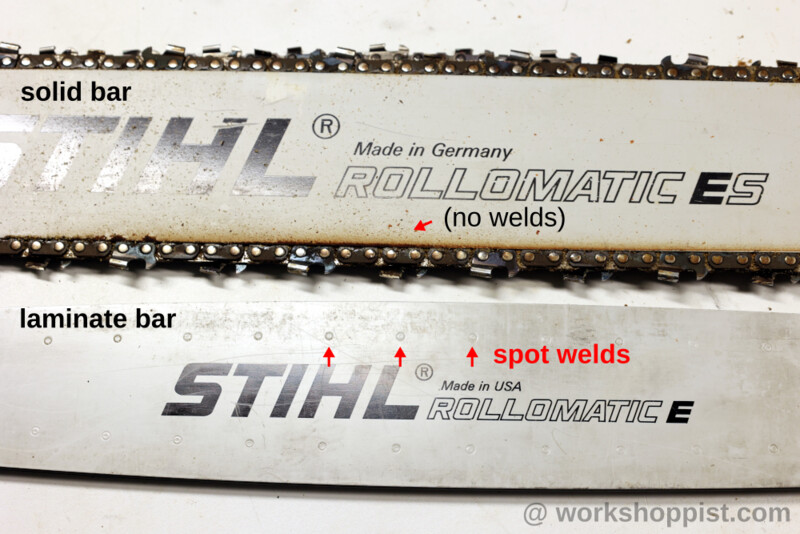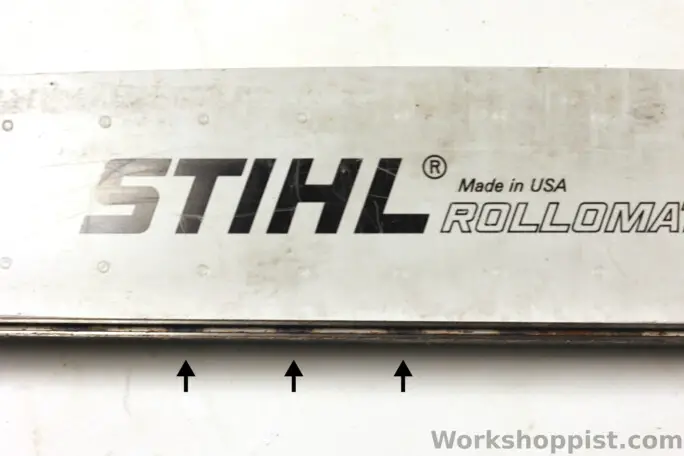Chainsaw guide bars come in two constructions: solid and laminate. Both laminate and solid guide bar models are available from all major manufacturers like Husqvarna, Oregon, Stihl, Sugihara and Tsumura. What difference does this make and which should you choose?
In this article, I will compare solid and laminate guide bars and help you choose. Summary: Laminate bars are more affordable and often lighter, but wear faster and are easier damaged. Solid guide bars are tougher and last longer, but also heavier and more expensive. Laminate bars are the right choice for small saws and occasional use or when weight is critical (climbing); solid bars should be preferred for long life and repairability in intensive professional use.
| SOLID VS LAMINATE GUIDE BARS |
|---|
| Solid: + more resistant to bending + more resistant to rail splaying or pinching + replaceable-nose or hard-nose – always heavy – mostly more expensive Laminate: + possibly lighter + often cheaper + sprocket, replaceable, or hard nose – bends easier – rails damaged easier |
How to tell a laminate guide bar?
A laminate guide bar can be identified based on the spot weld marks on the sides of the bar. These marks look like shallow dents and form a row around the bar perimeter (see image below). The marks are best spotted by observing light reflecting off the bar sides.
A solid guide bar can be identified by the lack of these spot weld marks: when viewed in grazing light, the sides of a solid guide bar are perfectly flat.

Solid bars are tougher
Solid bars are (in general) stronger and harder-wearing than laminate bars: they are more resistant to bending and splaying or pinching of the rails. The advantages are thanks to the excellent connection between the rails – they are one piece.
Contrast this with laminate bars, where the sides are connected only at the spot welds. This makes the rails on laminate bar less well supported and easier to bend in and out in rough use.
Solid bars are also easier to straighten by bending them back into shape. Although laminate bars can theoretically also be bent back, they do not seem to behave quite as well. I assume this is down to the not-so-reversible sliding between the core and faces and local stretching at the spot welds.
Solid bars are harder to make
Solid guide bars are more expensive because they are harder to manufacture: the rails and the deep groove between have to be milled into the bar. This process takes a lot of expensive CNC machine time.
Laminate guide bars are much easier to make: the sides and the core are cut from sheet separately and spot-welded together (see image below). The rails and groove are formed by the side and core piece shoulders – no further machining needed.

Laminate allows low weight
Laminate bars can be designed to be lighter than solid bars – usually up to around 30% lighter.
The key here is the bar core: smart engineering of cutouts into the core allow savings in steel weight. Leaving large sections out is possible because the strength requirements on the core are not very high: like the web of an I-beam, the core only transfers shear between the face plates.
Examples of light-weight laminate bars are the Stihl Rollomatic E Light and Rollomatic E Mini Light as well as Husqvarna X-Force and X-Tough Light.
Laminate bars are not always lighter, though. Affordable entry-level laminate bars may have a solid core plate and weigh essentially the same as a comparable solid bar.
When to choose solid vs. laminate?
Laminate bars are usually the best choice for cost-conscious homeowners. In fact, bars in light pitches (1/4P, 1/4″, .325P and 3/8P) employed in small under 40cc saws often only come in laminate options.
Laminate bars are also the way to go in weight-critical sawing. A prime example is arborist and in-tree work; another is long-bar all-day logging, where a 30% lighter saw makes the bar less tip-heavy.
Solid bars should be preferred when durability is key. This would be the case in most professional and/or intensive use. The longer life more than covers for the higher price, both with replaceable-nose and hard nose models.